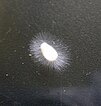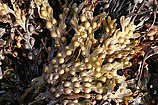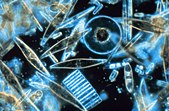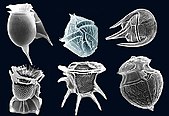Infrakingdom of protists
| Halvaria |
| |
| Important halvarian groups. Clockwise from top-left: a water mold (Oomycetes), a brown alga (Phaeophyta), some diatoms (Bacillariophyta), some dinoflagellates (Miozoa), some ciliates (Ciliophora) and an opalinid (Bigyra). |
Scientific classification  |
| Domain: | Eukaryota |
| Clade: | Diaphoretickes |
| Subkingdom: | SAR |
| Infrakingdom: | Halvaria
Cavalier-Smith 2010 |
| Superphyla and phyla[1] |
- Stramenopiles (=Heterokonta)
- Alveolata
|
Halvaria is a taxonomic grouping of protists that includes Alveolata and Stramenopiles (Heterokonta).[2]
Analyses in 2007 and 2008 revealed that the Stramenopiles and the Alveolata are related, and form a reduced clade of what were seen to be a paraphyletic group, the chromalveolates. The two clades together with the Rhizaria (originally one of the six major eukaryote groups) form a clade dubbed the SAR supergroup.[3][4][5]
A phylogenomic analysis from 2016 cast doubt on Halvaria, suggesting that Alveolata is the sister group to Rhizaria (making the R + A clade) through new rhizarian sequence data, and that support for Halvaria might be an artifact of low taxon sampling as well as long branch attraction.[6]
However, later analyses from 2021 support Halvaria as a solid clade.[7]
References
- ^ Cavalier-Smith, Thomas (2017). "Kingdom Chromista and its eight phyla: a new synthesis emphasising periplastid protein targeting, cytoskeletal and periplastid evolution, and ancient divergences". Protoplasma. 255 (1): 297–35 7. doi:10.1007/s00709-017-1147-3. PMC 5756292. PMID 28875267.
- ^ Cavalier-Smith, Thomas (June 2010). "Kingdoms Protozoa and Chromista and the eozoan root of the eukaryotic tree". Biology Letters. 6 (3): 342–345. doi:10.1098/rsbl.2009.0948. PMC 2880060. PMID 20031978.
- ^ Burki, F.; Shalchian-Tabrizi; K. Minge, M.; et al. (August 2007). "Phylogenomics reshuffles the eukaryotic supergroups". PLOS ONE. 2 (8): e790. doi:10.1371/journal.pone.0000790. PMC 1949142. PMID 17726520.

- ^ Burki, F.; Shalchian-Tabrizi; Pawlowski, J. (August 2008). "Phylogenomics reveals a new 'megagroup' including most photosynthetic eukaryotes". Biology Letters. 4 (4): 366–369. doi:10.1098/rsbl.2008.0224. PMC 2610160. PMID 18522922.
- ^ Kim, E.; Graham, L.E. (July 2008). "EEF2 analysis challenges the monophyly of Archaeplastida and Chromalveolata". PLOS ONE. 3 (7): e2621. doi:10.1371/journal.pone.0002621. PMC 2440802. PMID 18612431.

- ^ He, D.; Sierra, R.; Pawlowski, J.; Baldauf, S.L. (August 2016). "Reducing long-branch effects in multi-protein data uncovers a close relationship between Alveolata and Rhizaria". Molecular Phylogenetics and Evolution. 101: 1–7. doi:10.1016/j.ympev.2016.04.033. PMID 27132173.
- ^ Strassert, J.F.; Irisarri, I.; Williams, T.A.; Burki, F. (March 2021). "A molecular timescale for eukaryote evolution with implications for the origin of red algal-derived plastids". Nature Communications. 12 (1): 1879. doi:10.1038/s41467-021-22044-z. PMC 7994803. PMID 33767194.
- Domain
- Archaea
- Bacteria
- Eukaryota
- (major groups
- Excavata
- Diaphoretickes
- Hacrobia
- Rhizaria
- Alveolata
- Stramenopiles
- Plants
- Amorphea
- Amoebozoa
- Opisthokonta
- Animals
- Fungi)
|
|
|
|
| Incertae sedis | |
|---|
- ¹traditional kingdoms excluded from protists
- *paraphyletic groups
- bold denotes groups with over 1,000 species
|
Taxon identifiers |
|---|
| Halvaria | |
|---|























